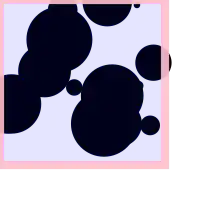Boolean model (probability theory)
For statistics in probability theory, the Boolean-Poisson model or simply Boolean model for a random subset of the plane (or higher dimensions, analogously) is one of the simplest and most tractable models in stochastic geometry. Take a Poisson point process of rate in the plane and make each point be the center of a random set; the resulting union of overlapping sets is a realization of the Boolean model . More precisely, the parameters are and a probability distribution on compact sets; for each point of the Poisson point process we pick a set from the distribution, and then define as the union of translated sets.

To illustrate tractability with one simple formula, the mean density of equals where denotes the area of and The classical theory of stochastic geometry develops many further formulae. [1][2]
As related topics, the case of constant-sized discs is the basic model of continuum percolation[3] and the low-density Boolean models serve as a first-order approximations in the study of extremes in many models.[4]
References
- Stoyan, D.; Kendall, W.S. & Mecke, J. (1987). Stochastic geometry and its applications. Wiley.
- Schneider, R. & Weil, W. (2008). Stochastic and Integral Geometry. Springer.
- Meester, R. & Roy, R. (2008). Continuum Percolation. Cambridge University Press.
- Aldous, D. (1988). Probability Approximations via the Poisson Clumping Heuristic. Springer.